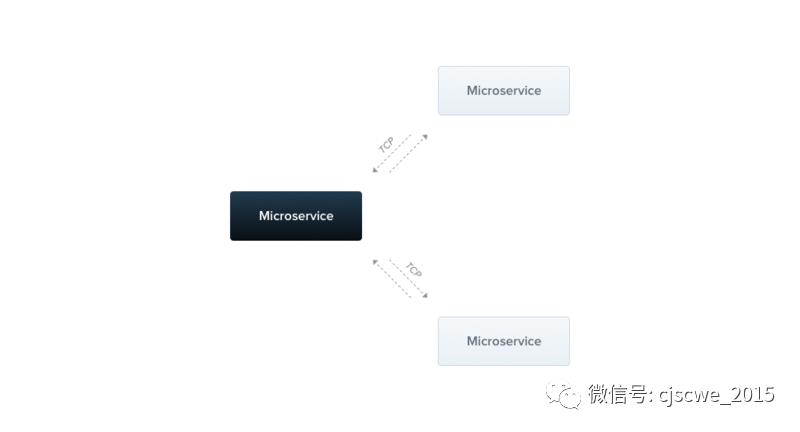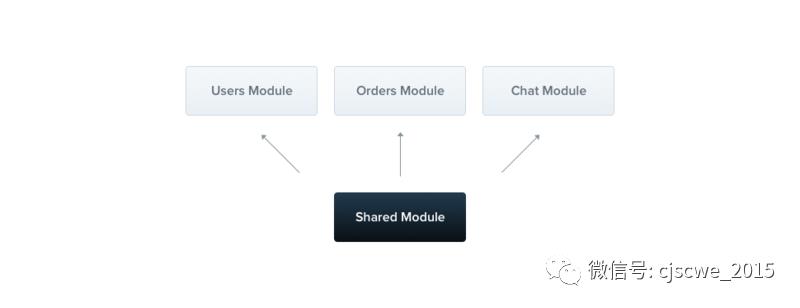第3章第359回基于 TypeScript 的 Node.js 框架 Nest 正式版发布!(下)
Posted 前端JavaScript
tags:
篇首语:本文由小常识网(cha138.com)小编为大家整理,主要介绍了第3章第359回基于 TypeScript 的 Node.js 框架 Nest 正式版发布!(下)相关的知识,希望对你有一定的参考价值。
作者,@Kamil Myśliwiec
中间件(Middlewares)
中间件是一个在路由处理程序前被调用的函数。中间件函数可以访问请求和响应对象,因此可以修改它们。它们也可以向一个屏障,如果中间件函数不调用 next(),请求将永远不会被路由处理程序处理。

让我们来构建一个虚拟授权中间件。我们将使用 X-Access-Token HTTP 头来提供用户名(这是个奇怪的想法,但是不重要)。
import { UsersService } from './users.service';
import { HttpException } from '@nestjs/core';
import { Middleware, NestMiddleware } from '@nestjs/common';
@Middleware()
export class AuthMiddleware implements NestMiddleware {
constructor(private usersService: UsersService) {}
resolve() {
return (req, res, next) => {
const userName = req.headers["x-access-token"];
const users = this.usersService.getUsers();
const user = users.find((user) => user.name === userName);
if (!user) {
throw new HttpException('User not found.', 401);
}
req.user = user;
next();
}
}
}
一些事实如下:
你应该使用 @Middleware() 注解来告诉 Nest,这个类是一个中间件,
你可以使用 NestMiddleware 界面,这强制你使用 resolve() 方法,
中间件(与组件相同)可以通过其构造函数的注入依赖项(依赖关系必须是模块的一部分),
中间件必须有 resolve() 方法,它必须返回另一个函数(高阶函数)。为什么?因为有很多第三方插件准备使用 express 中间件,你可以简单地在 Nest 中使用,还要感谢这个方案。
好了,我们已经准备好了中间件,但是我们并没有在任何地方使用它。我们来设置它:
import { Module, MiddlewaresConsumer } from '@nestjs/common';
@Module({
controllers: [ UsersController ],
components: [ UsersService ],
exports: [ UsersService ],
})
export class UsersModule {
configure(consumer: MiddlewaresConsumer) {
consumer.apply(AuthMiddleware).forRoutes(UsersController);
}
}
如上所示,模块可以有其他方法,configure()。此方法接收 MiddlewaresConsumer 对象作为参数,它可以帮助我们配置中间件。
这个对象有 apply() 方法,它接收到无数的中间件(这个方法使用扩展运算符,所以可以传递多个由逗号分隔的类)。 apply() 方法返回对象,它有两种方法:
forRoutes():我们使用这种方法通过逗号分隔控制器或对象(具有 path 和 method 属性),不限个数,
with():我们使用这种方法将自定义参数传递给 resolve() 中间件方法。
它如何工作?
当你在 forRoutes 方法中传递 UsersController 时,Nest 将为控制器中的每个路由设置中间件:
GET: users
GET: users/:id
POST: users
但是也可以直接定义应该使用哪个路径的中间件,就像这样:
consumer.apply(AuthMiddleware).forRoutes({
path: '*', method: RequestMethod.ALL
});
链(Chaining)
你可以简单的调用 apply() 链。
consumer.apply(AuthMiddleware, PassportMidleware)
.forRoutes(UsersController, OrdersController, ClientController);
.apply(...)
.forRoutes(...);
顺序
中间件按照与数组相同的顺序调用。在子模块中配置的中间件将在父模块配置之后被调用。
网关(Gateways)实时应用程序
Nest 中有特殊组件称为网关。网关帮助我们创建实时的网络应用程序。他们是一些封装的 socket.io 功能调整到框架架构。

网关是一个组件,因此它可以通过构造函数注入依赖关系。网关也可以注入到另一个组件。
import { WebSocketGateway } from '@nestjs/websockets';
@WebSocketGateway()
export class UsersGateway {}
默认情况下,服务器在 80 端口上运行,并使用默认的命名空间。我们可以轻松地改变这些设置:
@WebSocketGateway({ port: 81, namespace: 'users' })
当然,只有当 UsersGateway 在 components 模块组件数组中时,服务器才会运行,所以我们必须把它放在那里:
@Module({
controllers: [ UsersController ],
components: [ UsersService, UsersGateway ],
exports: [ UsersService ],
})
默认情况下,网关有三个有用的事件:
afterInit,作为本机服务器 socket.io 对象参数,
handleConnection 和 handleDisconnect,作为本机客户端 socket.io 对象参数。
有特殊的接口,OnGatewayInit, OnGatewayConnection 和 OnGatewayDisconnect 来帮助我们管理生命周期。
什么是消息
在网关中,我们可以简单地订阅发出的消息:
import { WebSocketGateway, SubscribeMessage } from '@nestjs/websockets';
@WebSocketGateway({ port: 81, namespace: 'users' })
export class UsersGateway {
@SubscribeMessage('drop')
handleDropMessage(sender, data) {
// sender is a native socket.io client object
}
}
而在客户端接收如下:
import * as io from 'socket.io-client';
const socket = io('http://URL:PORT/');
socket.emit('drop', { msg: 'test' });
@WebSocketServer()
如果要分配选定的 socket.io 本地服务器实例属性,你可以使用 @WebSocketServer() 装饰器来简单地进行装饰。
import { WebSocketGateway, WebSocketServer } from '@nestjs/websockets';
@WebSocketGateway({ port: 81, namespace: 'users' })
export class UsersGateway {
@WebSocketServer() server;
@SubscribeMessage('drop')
handleDropMessage(sender, data) {
// sender is a native socket.io client object
}
}
服务器初始化后将分配值。
网关中间件
网关中间件与路由器中间件几乎相同。中间件是一个函数,它在网关消息用户之前被调用。网关中间件函数可以访问本地 socket 对象。他们就像屏障一样,如果中间件函数不调用 next(),消息将永远不会由用户处理。
例如:
@Middleware()
export class AuthMiddleware implements GatewayMiddleware {
public resolve(): (socket, next) => void {
return (socket, next) => {
console.log('Authorization...');
next();
};
}
}
关于网关中间件的一些事实:
你应该使用 @Middleware() 注解来告诉 Nest,这个类是一个中间件,
你可以使用 GatewayMiddleware 界面,这迫使你实现 resolve() 方法,
中间件(和组件一样)可以通过其构造函数注入依赖项(依赖关系必须是模块的一部分),
中间件必须是 resolve() 方法,它必须返回另一个函数(高阶函数)
好了,我们已经准备好中间件,但是我们并没有在任何地方使用它。我们来设定一下:
@WebSocketGateway({
port: 2000,
middlewares: [ ChatMiddleware ],
})
export class ChatGateway {}
如上所示,@WebSocketGateway() 接受额外的元数组属性 - middlewares,它是一个中间件数组。这些中间件将在消息处理程序前调用。
反应流(Reactive Streams)
Nest 网关是一个简单的组件,可以注入到另一个组件中。这个功能使得我们有可能选择将如何对消息做出反应。
当然,只有有必要,我们可以向网关注入组件并调用其适当的方法。
但是还有另一个解决方案,网关反应流(Gateway Reactive Streams)。你可以在这里阅读更多关于他们的信息。
微服务(Microservices)支持
将 Nest 应用程序转换为 Nest 微服务是非常简单的。
让我们来看看如何创建 Web 应用程序:
const app = NestFactory.create(ApplicationModule);
app.listen(3000, () => console.log('Application is listening on port 3000'));
现在,切换到微服务:
const app = NestFactory.createMicroservice(ApplicationModule, { port: 3000 });
app.listen() => console.log('Microservice is listening on port 3000'));
就是这样!
通过 TCP 进行通信

默认情况下, Nest 微服务通过 TCP 协议监听消息。这意味着现在 @RequestMapping() (以及 @Post(), @Get() 等等)也不会有用,因为它是映射 HTTP 请求。那么微服务如何识别消息?只是通过模式。
什么是模式?没什么特别的,它是一个对象,字符串或者数字(但这不是一个好注意)。
让我们创建 MathController :
import { MessagePattern } from '@nestjs/microservices';
@Controller()
export class MathController {
@MessagePattern({ cmd: 'add' })
add(data, respond) {
const numbers = data || [];
respond(null, numbers.reduce((a, b) => a + b));
}
}
你可能会看到,如果你想创建消息处理程序,你必须使用@MessagePattern(pattern) 进行装饰。在这个例子中,我选择 { cmd: 'add' } 作为模式。
该处理程序方法接收两个参数:
data,它是从另一个微服务器(或者只是 Web 应用程序)发送的数据变量,
respond,接收两个参数(error 和 response)的函数。
客户端
你已经知道了如何接收消息。现在,我们来看看如何从另一个微服务器或者 Web 应用程序发送它们。
在你开始之前,Nest 必须知道你要发送的邮件的位置。很简单,你只需要创建一个 @Client 对象。
import { Controller } from '@nestjs/common';
import { Client, ClientProxy, Transport } from '@nestjs/microservices';
@Controller()
export class ClientController {
@Client({ transport: Transport.TCP, port: 5667 })
client: ClientProxy;
}
@Client() 装饰器接收对象作为参数。此对象可以有 3 个属性:
transport,通过这种方式,你可以决定使用哪种方法,TCP 或者 Redis(默认为 TCP)
url,仅用于 Redis 参数(默认为 redis://localhost:6379),
port,端口,默认为 3000。
使用客户端
让我们来创建自定义路径来测试我们的通信。
import { Controller, Get } from '@nestjs/common';
import { Client, ClientProxy, Transport } from '@nestjs/microservices';
@Controller()
export class ClientController {
@Client({ transport: Transport.TCP, port: 5667 })
client: ClientProxy;
@Get('client')
sendMessage(req, res) {
const pattern = { command: 'add' };
const data = [ 1, 2, 3, 4, 5 ];
this.client.send(pattern, data)
.catch((err) => Observable.empty())
.subscribe((result) => res.status(200).json({ result }));
}
}
正如你看到的,为了发送消息,你必须使用 send 方法,它接收消息模式和数据作为参数。此方法从 Rxjs 包返回一个 Observable 。
这是非常重要的特性,因为 Observables 提供了一组令人惊奇的操作来处理,例如combine, zip, retryWhen, timeout 等等。
当然,如果你想使用 Promise 而不是 Observables,你可以直接使用 toPromise() 方法。
就这样。
现在,当有人发送 /test 请求(GET)时,应该如何应用(如果微服务和 web 应用都可用):
{
"result": 15
}
Redis
还有另一种方式与 Nest 微服务合作。我们可以使用 Redis 的发布/订阅功能,而不是直接 TCP 通信。

在使用之前,你必须安装 Redis。
创建 Redis 微服务
要创建 Redis 微服务,你必须在 NestFactory.createMicroservice() 方法中传递其他配置。
const app = NestFactory.createMicroservice(
MicroserviceModule,
{
transport: Transport.REDIS,
url: 'redis://localhost:6379'
}
);
app.listen(() => console.log('Microservice listen on port:', 5667 ));
就这样。现在,你的微服务将订阅通过 Redis 发布的消息。其它方式依旧相同,如 模式和错误处理等等。
Redis 客户端
现在让我们来看看如何创建客户端。以前,你的客户端配置如下:
@Client({ transport: Transport.TCP, port: 5667 })
client: ClientProxy;
我们想使用 Redis 而不是 TCP, 所以我们必须改变这些配置:
@Client({ transport: Transport.REDIS, url: 'redis://localhost:6379' })
client: ClientProxy;
很容易,对么? 就是这样。其他功能与 TCP 通信中的功能相同。
共享模块
Nest 模块可以导出其它组件。这意味着,我们可以轻松地在它们之间共享组件实例。
在两个或者更多模块之间共享实例的最佳方式是创建共享模块。

例如,如果我们要在整个应用程序中共享 ChatGateway 组件,我们可以这样做:
import { Module, Shared } from '@nestjs/common';
@Shared()
@Module({
components: [ ChatGateway ],
exports: [ ChatGateway ]
})
export class SharedModule {}
然后,我们只需要将这个模块导入到另一个模块中,这个模块应该共享组件实例:
@Module({
modules: [ SharedModule ]
})
export class FeatureModule {}
就这样。
注意,也可以直接定义共享模块的范围,了解更多细节(https://kamilmysliwiec.gitbooks.io/nest/content/advanced/shared-module.html)。
依赖注入
依赖注入是一个强大的机制,可以帮助我们轻松地管理我们类的依赖。它是非常受欢迎的语言,如 C# 和 Java。
在 Node.js 中,这些功能并不重要,因为我们已经有了神奇的模块加载系统,如在文件之间共享实例的很容易的。
模块加载系统对于中小应用足够用了。当代码增长时,顺利组织层之间的依赖就变得更加困难。总有一天会变得爆炸。
它比 DI 构造函数更直观。这就是为什么 Nest 有自己的 DI 系统。
自定义组件
你已经了解到了,将组件添加到所选的模块是非常容易的。
@Module({
controllers: [ UsersController ],
components: [ UsersService ]
})
是还有一些其他情况, Nest 允许你利用。
使用 value :
const value = {};
@Module({
controllers: [ UsersController ],
components: [
{ provide: UsersService, useValue: value }
],
})
当:
你想要使用具体的值,现在,在这个模式中, Nest 将把 value 与 UsersService 元类型相关联,
你想要使用单元测试。
使用 class :
@Component()
class CustomUsersService {}
@Module({
controllers: [ UsersController ],
components: [
{ provide: UsersService, useClass: CustomUsersService }
],
})
当:
你只想在此模块中使用所选的更具体的类。
使用工厂
@Module({
controllers: [ UsersController ],
components: [
ChatService,
{
provide: UsersService,
useFactory: (chatService) => {
return Observable.of('value');
},
inject: [ ChatService ]
}
],
})
当:
你想提供一个值,它必须使用其他组件(或定制包特性)来计算,
你要提供异步值(只返回 Observable 或 Promise),例如数据库连接。
请记住:
如果要使用模块中的组件,则必须将它们传递给注入数组。 Nest 将按照相同的顺序传递作为参数的实例。
定制 providers
@Module({
controllers: [ UsersController ],
components: [
{ provide: 'isProductionMode', useValue: false }
],
})
当:
你想提供一个选择的键值。
请注意:
可以使用各种类型的 useValue, useClass 和 useFactory。
怎么使用?
使用选择的键注入自定义提供组件 / 值,你必须告诉 Nest,就像这样:
import { Component, Inject } from '@nestjs/common';
@Component()
class SampleComponent {
constructor(@Inject('isProductionMode') isProductionMode: boolean) {
console.log(isProductionMode); // false
}
}
ModuleRef
有时候你可能希望直接从模块引用获取组件实例。对于 Nest 并不是一件大事,你只需要在类中注入 ModuleRef :
export class UsersController {
constructor(
private usersService: UsersService,
private moduleRef: ModuleRef) {}
}
ModuleRef 提供一个方法:
get<T>(key),它返回等效键值实例(主要是元类型)。如 moduleRef.get<UsersService>(UsersService) 从当前模块返回 UsersService 组件的实例
例如:
moduleRef.get<UsersService>(UsersService)
它将从当前模块返回 UsersService 组件的实例。
测试
Nest 为你提供了一套测试工具,可以提供应用测试过程。可以有两种方法来测试你的组件和控制器,隔离测试和使用专用的 Nest 测试工具。
隔离测试
Nest 的控制器和组件都是一个简单的 javascript 类。这意味着,你可以很容易的自己创建它们:
const instance = new SimpleComponent();
如果你的类还有其它依赖,你可以使用 test doubles,例如 Jasmine 或 Sinon 库:
const stub = sinon.createStubInstance(DependencyComponent);
const instance = new SimpleComponent(stub);
专用的 Nest 测试工具
测试应用程序构建块的另一种方法是使用专用的 Nest 测试工具。
这些测试工具放在静态 Test 类中(@nestjs/testing 模块)。
import { Test } from '@nestjs/testing';
该类提供两种方法:
createTestingModule(metadata: ModuleMetadata),它作为参数接收简单的模块元数据(和 Module() class 相同)。此方法创建一个测试模块(与实际 Nest 应用程序相同)并将其存储在内存中。
get<T>(metatype: Metatype<T>),它返回选择的实例(metatype 作为参数传递),控制器/组件(如果它不是模块的一部分,则返回 null)。
例如:
Test.createTestingModule({
controllers: [ UsersController ],
components: [ UsersService ]
});
const usersService = Test.get<UsersService>(UsersService);
Mocks, spies, stubs
有时候你可能不想使用组件/控制器的实例。你可以选择这样,使用 test doubles 或者 自定义 values / objects 。
const mock = {};
Test.createTestingModule({
controllers: [ UsersController ],
components: [
{ provide: UsersService, useValue: mock }
]
});
const usersService = Test.get<UsersService>(UsersService); // mock
异常过滤器(Exception Filters)
使用 Nest 可以将异常处理逻辑移动到称为 Exception Filters 的特殊类。
如何工作?
让我们来看下下面的代码:
@Get('/:id')
public async getUser(@Response() res, @Param('id') id) {
const user = await this.usersService.getUser(id);
res.status(HttpStatus.OK).json(user);
}
想象一下,usersService.getUser(id) 方法会抛出一个 UserNotFoundException 异常。我们需要在路由处理程序中捕获异常:
@Get('/:id')
public async getUser(@Response() res, @Param('id') id) {
try {
const user = await this.usersService.getUser(id);
res.status(HttpStatus.OK).json(user);
}
catch(exception) {
res.status(HttpStatus.NOT_FOUND).send();
}
}
总而言之,我们必须向每个可能发生异常的路由处理添加 try ... catch 块。还有其它方式么? 是的,Exception Filters。
让我们创建 NotFoundExceptionFilter :
import { Catch, ExceptionFilter, HttpStatus } from '@nestjs/common';
export class UserNotFoundException {}
export class OrderNotFoundException {}
@Catch(UserNotFoundException, OrderNotFoundException)
export class NotFoundExceptionFilter implements ExceptionFilter {
catch(exception, response) {
response.status(HttpStatus.NOT_FOUND).send();
}
}
现在,我们只需要告诉我们的 Controller 使用这个过滤器:
import { ExceptionFilters } from '@nestjs/common';
@ExceptionFilters(NotFoundExceptionFilter)
export class UsersController {}
所以如果 usersService.getUser(id) 会抛出 UserNotFoundException,那么, NotFoundExceptionFilter 将会捕获它。
更多异常过滤器
每个控制器可能具有无限次的异常过滤器(仅用逗号分隔)。
@ExceptionFilters(NotFoundExceptionFilter, AnotherExceptionFilter)
依赖注入
Exception filters 与组件相同,因此可以通过构造函数注入依赖关系。
HttpException
注意:它主要用于 REST 应用程序。
Nest 具有错误处理层,捕获所有未处理的异常。
如果在某处,在你的应用程序中,你将抛出一个异常,这不是 HttpException(或继承的),Nest 会处理它并返回到下面用户的 json 对象(500 状态码):
{
"message": "Unkown exception"
}
异常层次结构
在应用程序中,你应该创建自己的异常层次结构(Exceptions Hierarchy)。所有的 HTTP 异常都应该继承自内置的 HttpException。
例如,您可以创建 NotFoundException 和 UserNotFoundException 类:
import { HttpException } from '@nestjs/core';
export class NotFoundException extends HttpException {
constructor(msg: string | object) {
super(msg, 404);
}
}
export class UserNotFoundException extends NotFoundException {
constructor() {
super('User not found.');
}
}
然后,如果你的应用程序中的某个地方抛出 UserNotFoundException,Nest 将响应用户状态代码 404 及以下 json 对象:
{
"message": "User not found."
}
它允许你专注于逻辑,并使你的代码更容易阅读。
有用的参考
GitHub / Download :
(https://github.com/kamilmysliwiec)
Documentation:
(https://kamilmysliwiec.gitbooks.io/nest/content/)
NPM:
(https://www.npmjs.com/package/nest.js)
>>>>>>>>>>>>>>>>>>>>>>>>>>>>>>>>>>>
>>>>>>>>>>>>>>>>>>>>>>>>>>>>>>>>>>>
====================
以上是关于第3章第359回基于 TypeScript 的 Node.js 框架 Nest 正式版发布!(下)的主要内容,如果未能解决你的问题,请参考以下文章